- United States
- /
- Water Utilities
- /
- NYSE:WTRG
Is Essential Utilities, Inc.'s (NYSE:WTRG) High P/E Ratio A Problem For Investors?

The goal of this article is to teach you how to use price to earnings ratios (P/E ratios). We'll apply a basic P/E ratio analysis to Essential Utilities, Inc.'s (NYSE:WTRG), to help you decide if the stock is worth further research. What is Essential Utilities's P/E ratio? Well, based on the last twelve months it is 65.02. That means that at current prices, buyers pay $65.02 for every $1 in trailing yearly profits.
See our latest analysis for Essential Utilities
How Do You Calculate Essential Utilities's P/E Ratio?
The formula for P/E is:
Price to Earnings Ratio = Price per Share ÷ Earnings per Share (EPS)
Or for Essential Utilities:
P/E of 65.02 = USD50.43 ÷ USD0.78 (Based on the trailing twelve months to September 2019.)
Is A High Price-to-Earnings Ratio Good?
A higher P/E ratio means that buyers have to pay a higher price for each USD1 the company has earned over the last year. All else being equal, it's better to pay a low price -- but as Warren Buffett said, 'It's far better to buy a wonderful company at a fair price than a fair company at a wonderful price'.
How Does Essential Utilities's P/E Ratio Compare To Its Peers?
The P/E ratio essentially measures market expectations of a company. The image below shows that Essential Utilities has a higher P/E than the average (38.1) P/E for companies in the water utilities industry.

Its relatively high P/E ratio indicates that Essential Utilities shareholders think it will perform better than other companies in its industry classification. Shareholders are clearly optimistic, but the future is always uncertain. So investors should always consider the P/E ratio alongside other factors, such as whether company directors have been buying shares.
How Growth Rates Impact P/E Ratios
Companies that shrink earnings per share quickly will rapidly decrease the 'E' in the equation. That means even if the current P/E is low, it will increase over time if the share price stays flat. So while a stock may look cheap based on past earnings, it could be expensive based on future earnings.
Essential Utilities shrunk earnings per share by 45% over the last year. And over the longer term (5 years) earnings per share have decreased 8.3% annually. This growth rate might warrant a below average P/E ratio.
Don't Forget: The P/E Does Not Account For Debt or Bank Deposits
It's important to note that the P/E ratio considers the market capitalization, not the enterprise value. That means it doesn't take debt or cash into account. In theory, a company can lower its future P/E ratio by using cash or debt to invest in growth.
Such spending might be good or bad, overall, but the key point here is that you need to look at debt to understand the P/E ratio in context.
Essential Utilities's Balance Sheet
Net debt totals just 9.5% of Essential Utilities's market cap. The market might award it a higher P/E ratio if it had net cash, but its unlikely this low level of net borrowing is having a big impact on the P/E multiple.
The Verdict On Essential Utilities's P/E Ratio
Essential Utilities's P/E is 65.0 which suggests the market is more focussed on the future opportunity rather than the current level of earnings. With modest debt but no EPS growth in the last year, it's fair to say the P/E implies some optimism about future earnings, from the market.
Investors should be looking to buy stocks that the market is wrong about. People often underestimate remarkable growth -- so investors can make money when fast growth is not fully appreciated. So this free report on the analyst consensus forecasts could help you make a master move on this stock.
Of course, you might find a fantastic investment by looking at a few good candidates. So take a peek at this free list of companies with modest (or no) debt, trading on a P/E below 20.
If you spot an error that warrants correction, please contact the editor at editorial-team@simplywallst.com. This article by Simply Wall St is general in nature. It does not constitute a recommendation to buy or sell any stock, and does not take account of your objectives, or your financial situation. Simply Wall St has no position in the stocks mentioned.
We aim to bring you long-term focused research analysis driven by fundamental data. Note that our analysis may not factor in the latest price-sensitive company announcements or qualitative material. Thank you for reading.
About NYSE:WTRG
Essential Utilities
Through its subsidiaries, operates regulated utilities that provide water, wastewater, and natural gas services in the United States.
Undervalued average dividend payer.
Similar Companies
Market Insights
Community Narratives





